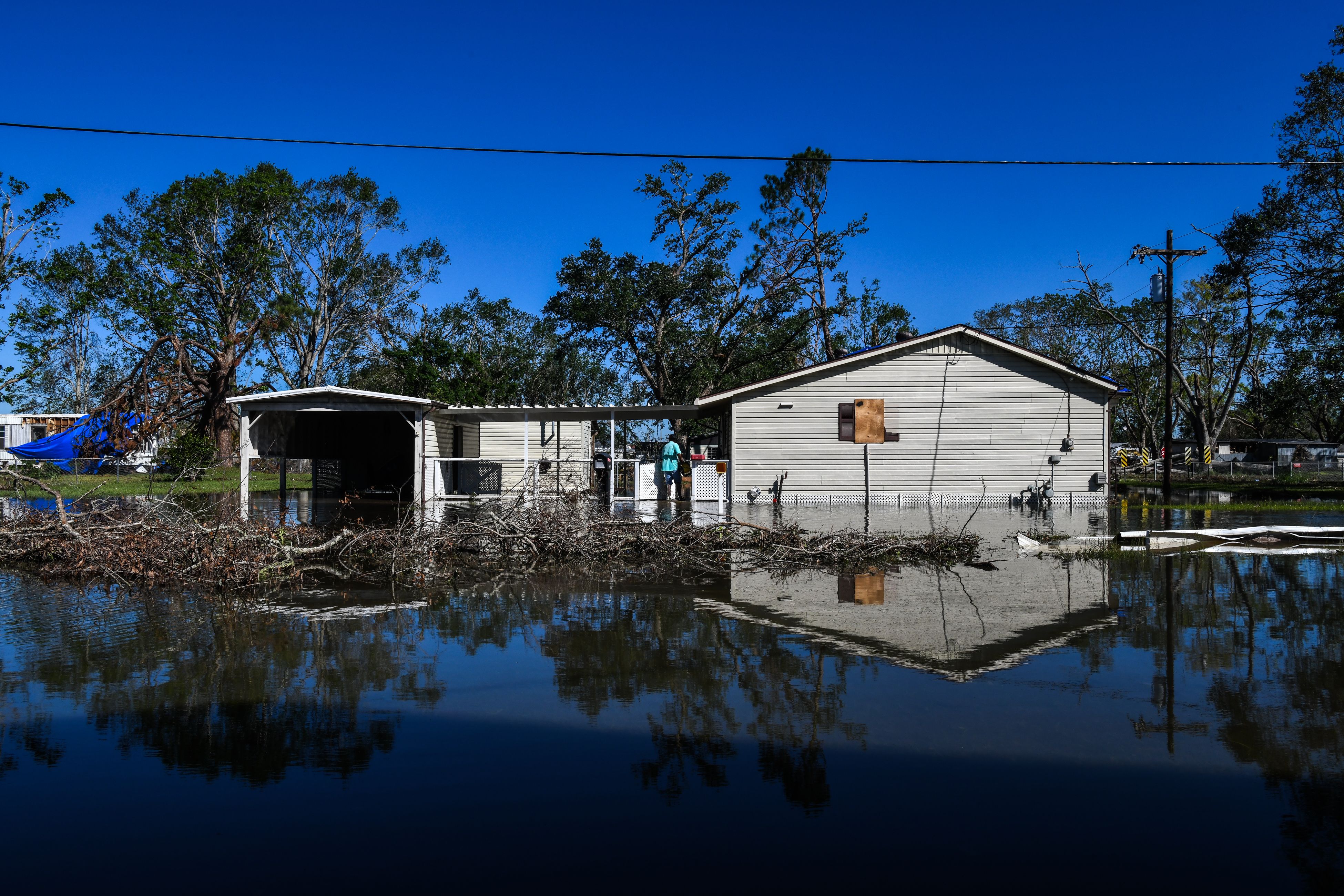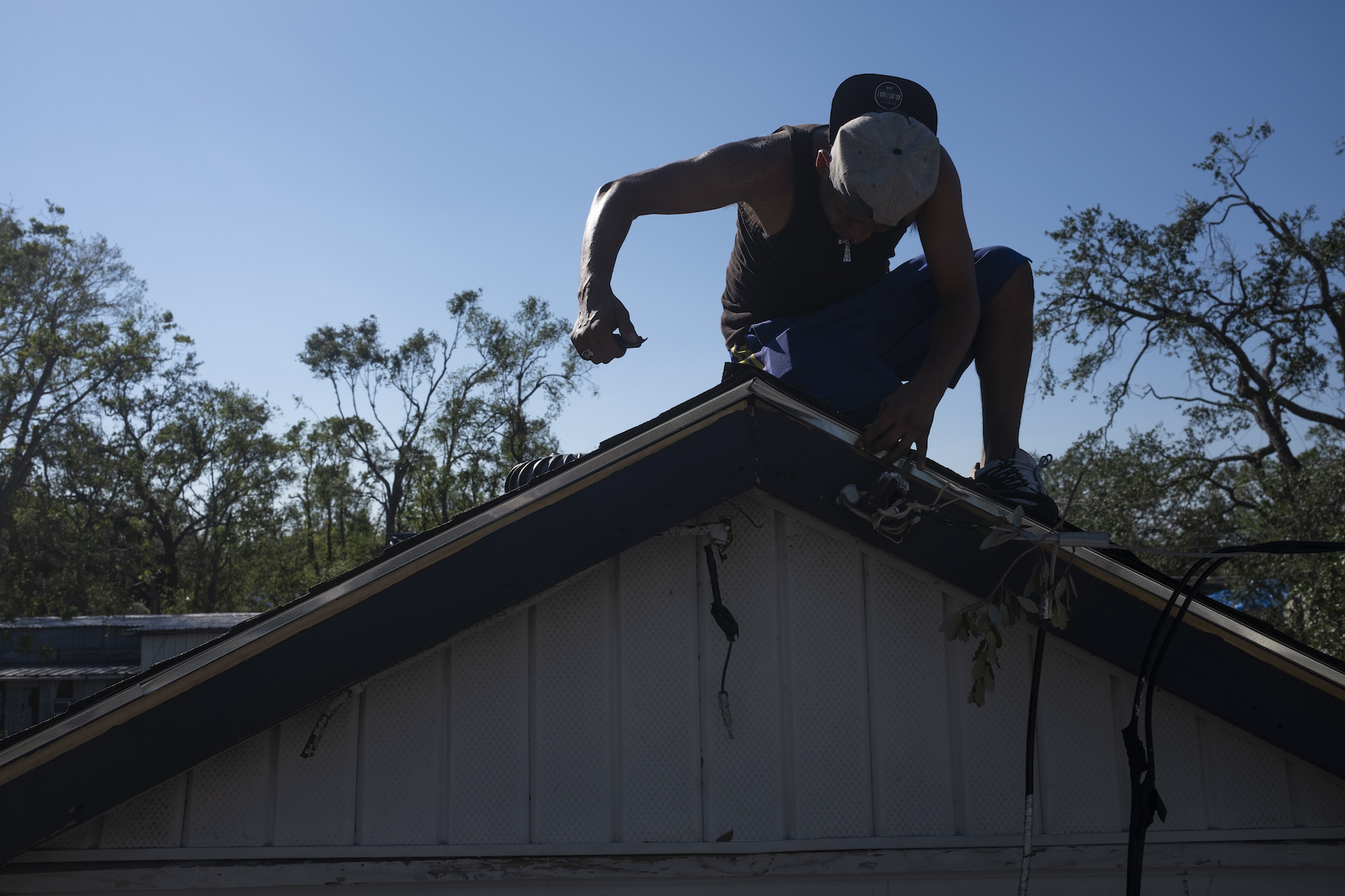In early May, President Joe Biden stood in front of the 70-year old Calcasieu River Bridge in Lake Charles, Louisiana. With the aging bridge in the background, he spoke about the hurricanes that have battered the town over the last year, emphasizing the need for infrastructure to adapt to the increasing severity of storms influenced by climate change. “The people of Louisiana always have picked themselves up, just like America always picks itself up,” he said, adding that the U.S. needs to “build back in a way that all we build is better able to withstand storms.”
But sometimes, the best way to build back better might be to just pick up and build elsewhere. Just 10 miles from the bridge where Biden gave his speech, the Greinwich Terrace neighborhood of Lake Charles has been slated by the state of Louisiana for optional buyouts — a program where the government will buy property that is frequently affected by flooding, allowing the residents to relocate out of harm’s way.
Lake Charles has been hit by three federally declared weather disasters in the last year, including Hurricanes Delta, Laura, and Winter Storm Viola.* At the end of May it was once again hit with a once-in-a-century rainstorm, causing widespread flooding. The repeated disasters have taken a toll. “We are a very resilient people. We are a very strong population,” Lake Charles Mayor Nic Hunter said after May’s flooding. “But, you know, eventually you do kind of get to a point where you ask Mother Nature: What more can you do to us?”
Some have already chosen to leave — Lake Charles had the biggest outward migration of population in the country last year, with 6.7 percent of residents leaving — perhaps in part due to displacement by the storms.
The $30 million voluntary buyout program announced by Louisiana Governor John Bel Edwards on the heels of May’s floods suggests that part of the way forward for Lake Charles residents is to get out of harm’s way. The buyouts are a part of a larger $1.2 billion federal mitigation grant to the state of Louisiana from the U.S. Department of Housing and Urban Development’s Community Development Block Grant Mitigation (CDBG-MIT) program.
In other words, it’s a pool of money designed to be spent on making a community more resilient now so it won’t need as much disaster recovery later. In this case, the money will likely fund buyouts for 90 to 100 homes in the neighborhood, says Pat Forbes, executive director of the Louisiana Office of Community Development. The land parcels, once purchased, cannot be redeveloped with housing or businesses, says Forbes, but will be reserved for uses like parks, soccer fields, or wetlands, that will allow for the land to be returned to the floodplain and absorb stormwater in future flooding events.

What’s happening in Lake Charles is a situation that millions of Americans may soon face — the decision to retreat from rising waters. Between 4 and 13 million Americans live in coastal areas that could be flooded by 2100, and buyouts are one of the few policy levers that governments have for enacting managed retreat — the coordinated movement of communities away from climate threats such as rising seas and fires. But historically, buyouts have been “a very small proportion of disaster risk reduction,” says Linda Shi, assistant professor of city and regional planning at Cornell University. So far, between 1989 and 2017 only 40,000 households took advantage of buyouts funded by the Federal Emergency Management Agency, the agency which oversees most of the nation’s buyouts.
So far, managed retreat has been a political third rail — barely addressed even in Biden’s climate-oriented infrastructure plan. Wishing away the problem by installing seawalls and other massive infrastructural interventions, however, isn’t realistic, according to Shi. “There are so many places that will be at risk that you cannot afford to put in infrastructure everywhere,” she said. Managed retreat, to some degree, will have to be part of the solution. But the current scale of buyout programs compared to the number of people at risk is not anywhere that it currently needs to be, says Shi: “40,000 versus 13 million — that’s a big figure.”
With the need to scale up buyouts come major equity questions that have historically accompanied buyout programs. Income targets for buyout neighborhoods or caps for how much a program will pay out for a property means that municipalities will often “end up targeting households that are lower income,” says Shi. A. R. Siders, assistant professor at the University of Delaware, says that this feature is in part due to the fact that government programs make cost-effectiveness calculations when choosing which communities to buy out and which to protect with infrastructure. It’s not as cost-effective to buy out one million-dollar property with a million dollars in funds, compared to ten properties worth a hundred-thousand dollars, says Siders, but this calculation drives equity imbalances in which communities are targeted to move. “The fact that we’re using infrastructure, and value of infrastructure, rather than people, as decision-making criteria — that’s what drives the inequity,” says Siders, “We’re valuing buildings, not people.”
Shi wonders if focusing on low-income or Black and Hispanic communities for buyouts is an “equity forward approach” — or if it’s a “racial targeting approach,” making certain communities move while others are protected by infrastructure. Past research in North Carolina has shown that wealthier, whiter communities were targeted for sea walls, while lower income, Black communities were targeted for buyouts — more broadly, neighborhoods with higher “social vulnerability” are more likely to be abandoned than protected as sea levels rise. That being said, low-income white residents have more frequently received buyouts than their Black counterparts, while Black households that are bought out tend to receive less money. Similarly, historical patterns of disinvestment in low-income neighborhoods and communities of color leads to infrastructure disparities that also exacerbate risk factors, like poor drainage systems, that can lead to a community being slated for buyouts, says Shi.
But the buyouts in Lake Charles have advantages for the residents who accept them; a major equity boon of the program, according to Forbes, is that it can offer more than the fair market value of the homes that are being purchased, which offsets the depression in value that accompanies being in a flood-prone area. For this reason, the last two buyouts Forbes has overseen have had 100 percent participation, in part because families are then able to move into higher-value housing. Participants know they will “wind up with a more valuable home by virtue of the fact that the fair market value of their home was probably depressed due to the floodplain,” says Forbes. “It’s quite an incentive.”
Still, according to Shi, a more equitable approach to managed retreat requires looking beyond risk and instead asking why people are vulnerable in the first place, and why there may not be affordable housing for them to move to. “Trying to make the buyout program itself equitable is like trying to make the chairs on the Titanic floatable — it’s limited in its utility in a certain sense because the drivers of the problem of where people go is far beyond that,” says Shi.
In the meantime, the buyouts will allow residents who accept it to start rebuilding wealth in their homes by retreating, says Forbes. “We’re focusing on helping people get to a safer, higher, drier place to live.”
*Correction: This story originally misstated the number of federally declared weather disasters to hit Lake Charles.



